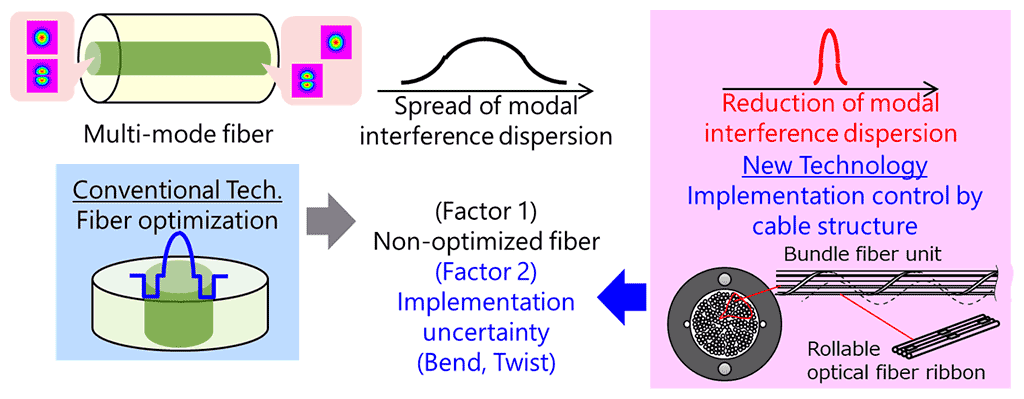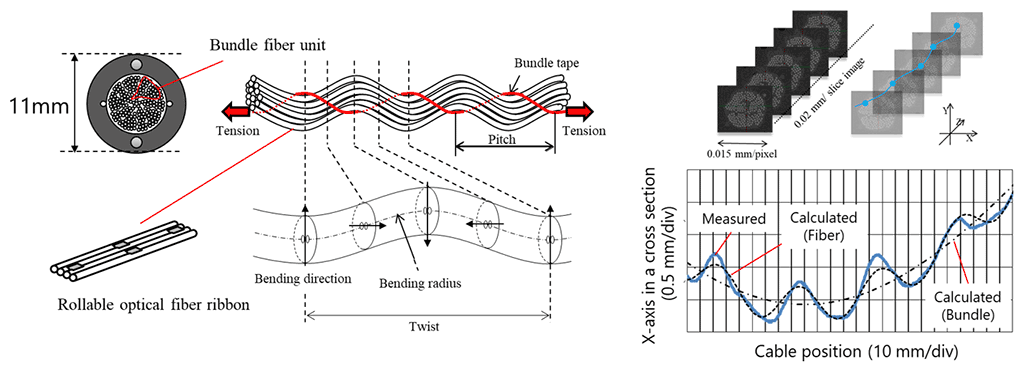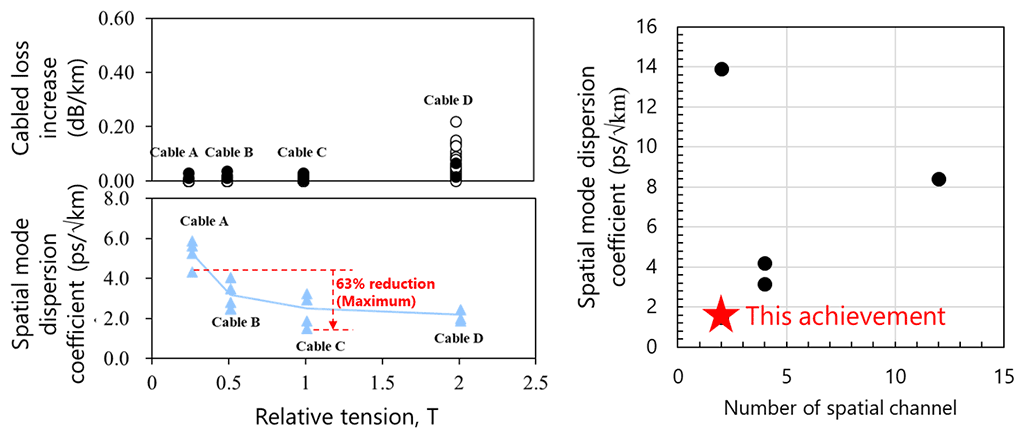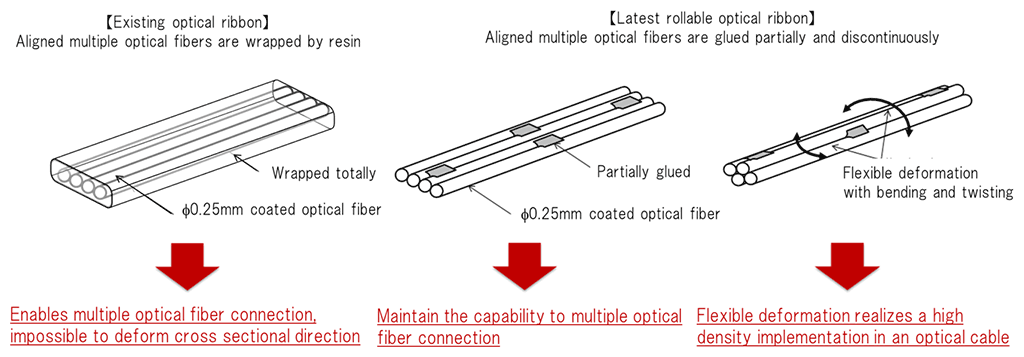Microsoft ends support for Internet Explorer on June 16, 2022.
We recommend using one of the browsers listed below.
- Microsoft Edge(Latest version)
- Mozilla Firefox(Latest version)
- Google Chrome(Latest version)
- Apple Safari(Latest version)
Please contact your browser provider for download and installation instructions.
March 9, 2020
Nippon Telegraph and Telephone Corporation
World’s First Attempt at Optical Transmission Property Control by Optimizing Optical Cable Structure
-Milestone for Realizing Long-haul and Large-capacity Mode-multiplexing Optical Transmission Links-
Nippon Telegraph and Telephone Corporation (NTT) has, for mode division multiplexing transmission, succeeded in reducing the transmission time difference between different kinds of optical signals (namely modes) in the same optical fiber, by optimizing the optical cable structure for the first time in the world.
Mode division multiplexing can increase the transmission capacity by means of the number of mode, however the transmission time difference between different modes needs complex signal processing at the receiver end. We reveal that the bending and twisting parameters of installed optical fibers can be managed by optimizing cable structural parameters such as bundling strength and pitch on multiple optical fibers, and prove that the transmission time variation caused by interference between different modes can be reduced by up to 60%. This achievement reveals that transmission property can be controlled by means of simultaneous optimization of optical fiber and optical cable, and this novel concept is expected to be beneficial for realizing an optical transmission links which can be used for mode division multiplexing transmission.
We will continue research into optimizing optical fiber and cable technology including connections and other key elements, and aim to contribute for realization of a large-capacity optical transmission backbone provides reliable infrastructure for IOWN*1.
This remarkable achievement was accepted as a top scored paper in the Optical Fiber Communication Conference (OFC) 2020 held in San Diego (CA), and it will be presented on March 9th, 2020 (PST).
 Figure 1 Schematic image of modal interference dispersion control in a multi-mode optical fiber cable
Figure 1 Schematic image of modal interference dispersion control in a multi-mode optical fiber cable
Research Background
Upcoming technologies, such as 5G, IoT (Internet of Things) and so on, have been increasing data capacity in optical communication networks exponentially. Space division multiplexing technology, which is expected to overcome the capacity limitation of an existing optical fiber, has been researched all over the world in order to handle the increasing data capacity demand. Optical fiber for space division multiplexing can be classified into two types. The first one contains multiple individual optical paths (cores) in one optical fiber, namely the multi-core fiber. The other propagates multiple kinds optical signal (modes) through one core, namely multi-mode fiber.
Regarding research on multi-core fiber, NTT has already developed a four-core fiber that has the same thinness as standard optical fiber, and its the applicability to long-haul and large capacity transmission has been proven*2.
In addition to refining multi-core technology, it is mandatory to use the multi-mode technology effectively in order to support the continuous increase in data capacity demand in a sustainable manner. However, the propagation time difference between different modes increases the problem of modal interference dispersion at the receiver end, which requires complex digital signal processing to offset. The modal interference dispersion can be reduced by optimizing the optical fiber structure. However, it is difficult to manage the modal interference dispersion in installed optical cable and concatenated optical links since the modal interference dispersion also depends on the implementation condition of the optical fiber such as bends and twists.
Summary of Achievements
By optimizing the structural parameters of NTT’s high-density optical cable*3, NTT realized:
- Precise control of bending and twisting parameters of installed optical fibers,
- Low loss and reduced modal interference dispersion properties simultaneously.
Based on these technical backgrounds:
- NTT has succeeded to realizing a high-density multi-mode fiber cable with the world’s lowest value of modal interference dispersion.
As a result, we have, for the first time, successfully demonstrated the controllability of optical properties using optimizing the design parameters of optical cable. These achievements show the feasibility of realizing optical links for long-haul and large capacity mode-division multiplexing transmission.
Detail of Achievements
1.Optical fiber installation control in a high-density optical cable
As shown as the left top cross sectional image, NTT’s high-density optical cable can install more than 200 optical fibers in a cable diameter of around 10 mm. This high-density property is realized by employing a rollable optical fiber ribbon*4 as shown as the left bottom image which can be deformed flexibly in its cross sectional direction since the neighboring cores are partially and discontinuously glued along their length. High-density optical cable are filled with some bundle fiber units, each of which is composed of a rollable optical fiber ribbons as the almost densest conditions. A region encircled with a red line in the left top cross section corresponds to one bundle fiber unit. Here, the bending and twisting parameters of the bundled optical fibers can be controlled by changing the tension and pitch of each bundle tape as shown in the middle of Fig. 2. We have confirmed that the relationship between tension and implementation parameters of the optical fibers can be described by a double helix structure model; this conformation involved examining X-ray cross sectional images of the fabricated cables as shown as the right top of Fig. 3. Right bottom of Fig. 3 shows the X axial position of a particular optical fiber as a function of the cable position. Blue solid line shows measured result, and it agrees well with the calculated results (dashed and dot-dashed lines, they correspond to the spatial position of optical fiber and bundle tape, respectively).
 Figure 2 Left: Schematic image of optical fiber implementation control in a high-density optical cable.
Figure 2 Left: Schematic image of optical fiber implementation control in a high-density optical cable.
Right: Experimental example of longitudinal optical fiber implementation inspection in a high density optical cable using X-ray cross section image.
2.Low loss and reduced modal interference dispersion properties
Generally, small bends and localized pressure points in a cabled optical fiber increase the loss after the cabling process. In this achievement, we reveal the influence of the bundle tape tension on both the cable loss increase and modal interference dispersion (spatial modal dispersion coefficient)*5. Here, multi-mode fiber can be designed using two different approaches: one enlarges the core diameter (namely single-core type), and the other uses the optical power transfer (coupling) phenomena between multiple cores (namely coupled-core type). In this experiment, we considered a coupled-core type multi-mode fiber*6 since the coupled-core type is more sensitive to the bending and twisting conditions, and we used two-core for two-mode transmission. We fabricated four cables (cable A-D) with the different tensions, and examined their optical transmission property. Left top and bottom of Fig. 3 show relative tension dependence of cabled loss increase and spatial mode dispersion coefficient, respectively. It can be seen that cabled loss increases with excessive tension. It is also found that spatial mode dispersion coefficient tends to decrease and then saturate as tension is increased. Left hand figures reveal that cable C enables a 60% reduction in spatial mode dispersion coefficient compared with cable A, i.e. almost tension free. As a result, we obtained the world’s lowest spatial mode dispersion coefficient of 1.5 ps/√km as shown in the right figure. It would be noted that filled circles in right figure did not consider any optimization of optical fiber condition and/or optical cable structure. Here, a 60% reduction in a spatial mode dispersion coefficient enables us to expand a transmission distance more than 6 times. These results reveal that our proposed technique can manage the implementation parameters of optical fiber, and provides future possibility to realize a long-haul and large capacity optical links for mode-division multiplexing transmission.
 Figure 3 Left: Relative tension dependence of cabled loss increase and spatial mode dispersion coefficient
Figure 3 Left: Relative tension dependence of cabled loss increase and spatial mode dispersion coefficient
Right: Reported examples of spatial mode dispersion coefficient
Future Prospects
The present achievement indicates that modal interference dispersion management can be realized by optimizing optical fiber and cable simultaneously. This achievement is expected to open up further capacity enlargement based on mode-multiplexing transmission by harmonizing with optical transmission and signal processing technology.
NTT also succeeded transpacific class mode-multiplexing transmission by utilizing novel transmission technology. This achievement was also accepted as a top scored paper in the OFC2020, and will be presented on 12 March.
We will continue optimizing an optical fiber and cable technology including connection and the other key elements. NTT aims to realize mode-multiplexing based long-haul and large capacity optical transmission system under harmonized work between optical fiber cable and optical transmission technologies.
Glossary
- IOWN (Innovative Optical and Wireless Network)
IOWN is future communications infrastructure to realize a smarter world by using cutting-edge technologies like photonics and computing technologies. - World's Largest Transmission Capacity with Standard Diameter Multi-Core Optical Fiber
https://www.ntt.co.jp/news2017/1708e/170808b.html - Development of world’s highest-density optical fiber cable
https://www.ntt.co.jp/news2012/1207e/120704a.html - Rollable optical fiber ribbon
An optical ribbon composed of multiple optical fibers aligned in cross sectional direction, enables to connect multiple optical fibers at a time. It is beneficial for improving the installation and operation efficiency of a high count optical cables. Existing optical ribbon can’t deform in its cross sectional direction since the neighboring optical fibers are totally wrapped and fixed by resin. The latest rollable optical ribbon can be deformed flexibly since the neighboring optical fibers are glued partially and intermittently, and enables densely bundled optical fibers. - Spatial mode dispersion coefficient
Modal interference dispersion in the time domain; it and which increases in proportional to the square root of the transmission distance. - Coupled-core type multi-mode fiber
Multi-mode fiber can be classified into two types. One propagates multiple-mode signals in one core, namely single-core type. The other supports N mode transmission by using optical coupling between N cores. In this achievement, we used a two-core coupled-type multi-mode fiber that can propagate two-mode.
 Figure 4 Schematic image of rollable optical ribbonFigure 4 Schematic image of rollable optical ribbon
Figure 4 Schematic image of rollable optical ribbonFigure 4 Schematic image of rollable optical ribbon
(https://www.ntt.co.jp/news2012/1207e/120704a_3.html)
 Figure 5 Schematic image of single-core and coupled-core type multi-mode fibers
Figure 5 Schematic image of single-core and coupled-core type multi-mode fibers
Contact Information
Nippon Telegraph and Telephone Corporation
Information Network Laboratory Group, Public Relations
E-mail:inlg-pr-pb-ml@hco.ntt.co.jp
Information is current as of the date of issue of the individual press release.
Please be advised that information may be outdated after that point.
NTT STORY
WEB media that thinks about the future with NTT










